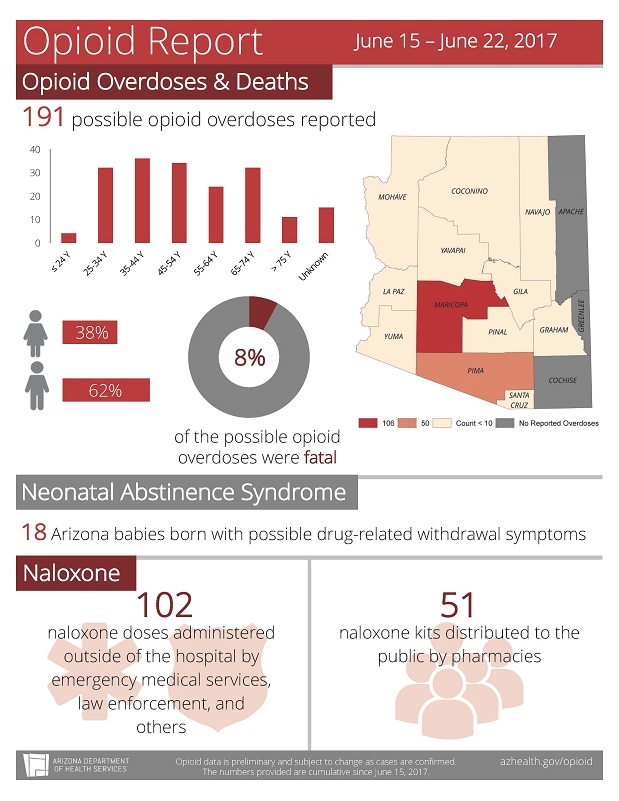 This week we posted our first report of real time data reported to us from healthcare providers, first responders, law enforcement agencies, and pharmacists in our coordinated response to the alarming increase in opioid deaths in Arizona. Between June 15 and June 22, 191 suspected opioid overdoses, 15 of them fatal, were reported to ADHS in our first week of data collection under Governor Ducey’s executive order for enhanced surveillance.
This week we posted our first report of real time data reported to us from healthcare providers, first responders, law enforcement agencies, and pharmacists in our coordinated response to the alarming increase in opioid deaths in Arizona. Between June 15 and June 22, 191 suspected opioid overdoses, 15 of them fatal, were reported to ADHS in our first week of data collection under Governor Ducey’s executive order for enhanced surveillance.
In addition to learning more immediate information about suspected opioid-related overdoses and deaths, we learned in the first week of reporting, 18 babies were born with possible drug-related withdrawal symptoms. First responders across the state, including emergency medical services and law enforcement personnel, administered 102 doses of naloxone in an attempt to reverse overdoses and save lives. Pharmacies reported dispensing 51 naloxone kits in that first week.
These numbers are probably lower than what’s actually occurring in our communities because not everyone who is required to report is likely submitting data yet. As we continue to collect data, we expect to see those numbers increase week to week. As more data is reported, our reports will evolve to include additional important pieces of information to help ADHS and our partners better understand the burden of opioids in Arizona and improve our ability to target intervention activities to turn the tide on opioid deaths in Arizona.
In the past week, we’ve accomplished additional significant activities apart from collecting and analyzing opioid data . Primary among these include the day-long Goal Council 3 event we hosted on June 26. Goal Council 3, established by Governor Ducey as part of the Arizona Management System framework to focus on Healthy People, Places, and Resources, identified a breakthrough project to reduce the number of opioid deaths in Arizona.
The Goal Council event brought together almost 170 partners from across the state who are committed to working on this goal in a systematic, data-driven fashion. Participants broke into subgroups and worked in problem solving sessions facilitated by the Government Transformation Office to formulate ideas and implement actions to reduce opioid deaths. This was the kick-off session for the innovative work the Goal Council and its subgroups will do to achieve the goal over the next several years.
This week, we also held our third naloxone administration training in Phoenix, with more than 430 law enforcement officers and other partners in attendance. That marks more than 750 people who have been trained to administer this important overdose reversal medication in the last two weeks. Law enforcement agencies whose staff have completed these trainings or trainings consistent with ADHS or AZ-POST standards are eligible for free naloxone.
You can stay up to date on the latest opioid emergency response activities by visiting our website www.azhealth.gov/opioid. If you’d like to get involved, please let us know.











